

By Clément Miège
Kulusuk, 26 March 2014 — “Opa” is a Greenlandic word for “maybe”, as we learned it this morning while talking to Danish guests at the hotel Kulusuk who have been stuck for a few days due to bad weather.
To give you a little bit of background, the southeastern part of Greenland witnesses the highest precipitation rates of the island, in conjunction with strong winds (either from the ocean or the ice sheet). Often, the weather is unpredictable, especially at this time of year. Therefore, conducting fieldwork in southeast Greenland is a gamble.
Last year, when we experience really great weather in Kulusuk the week before our field work, we did not fully realize how lucky we were to be able to go to the field as scheduled. This year, it has been a different story: we have already gone through two storm systems, and yesterday night a third storm hit us, with a lot of wind and snow. We feel like we are paying the price of last year’s fantastic weather.
That being said, this weather is good to prepare the cargo for our flights to the ice sheet. We spent a good part of Sunday getting the low-frequency radar system ready. We worked on the radar sleds, as well as on the tube that will keep the radar antenna straight when we drag the system on the snow surface.

Ludo and Clem, working on gluing the coupling made to connect the radar antenna tubes. (Credit: Rick Foster.)
On Monday, we went to the village of Kulusuk to buy some supplies (we are currently staying in a hotel that is about a 30-minute walk from the village). On our way to the village, we saw four teams of dog sleds ready to leave for Apusiaajik glacier. The dog sleds are carrying skiers and a week-worth of their base camp materials, so the skiers can enjoy the fresh snow!
We walked around the village to get some nice views of the ocean and the sea ice. As we were walking, Ludo made a local friend! A Greenlandic kid who was a really fun guide and gave us a tour for an hour. At some point, we realized that he was always avoiding the direction of the school!
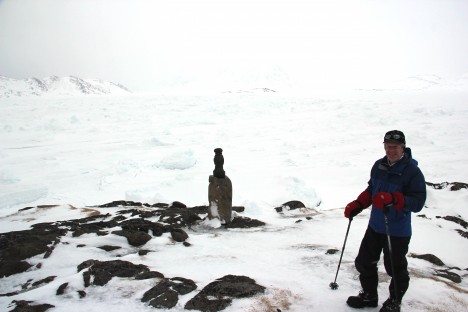
Rick in front of the broken and refrozen sea ice. Imagine how different it is from the open ocean in the summer, with boats cruising around. (Credit: Clément Miège.)
After that, we went to the store and got some food and a propane tank for our stove on the ice sheet. We found everything we needed and headed back to the hotel. We finished the day at the airport further organizing the science equipment.
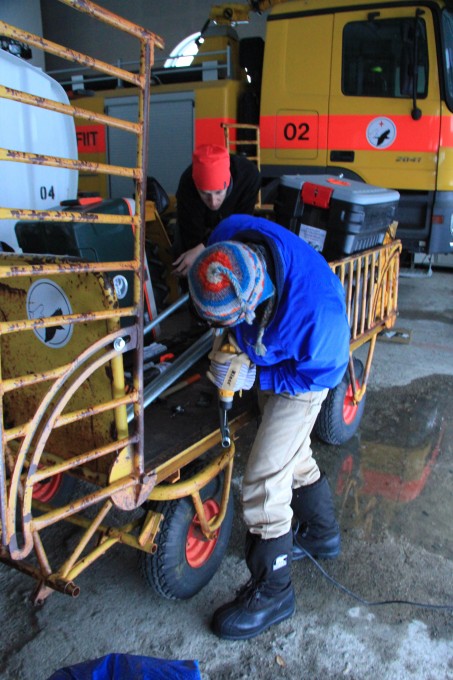
Rick works on an extension of the ARGOS antenna mast that we already have installed in the field. (Credit: Clément Miège.)
Tuesday, Ludo and I went back to the airport warehouse and finished organizing the cargo for the helicopter flights. We’ve prepared two distinct: one consists of our camp gear, sleep kits, food, personal gear, and some science equipment. The other (which can arrive later), is composed by the rest of the science gear.
Wednesday has been different, and we thought it would be “fun” to walk you through the steps that we have gone through today in terms of decision-making:
In the morning, Thursday’s flight is still ‘opa’. We are optimist and getting ready to leave, packing personal bags and organizing the last bits of equipment.
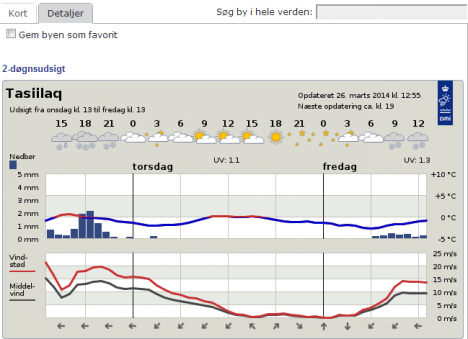
Weather forecast, from the Danish Meteorological Institute, for today Wednesday (March 26) and Thursday (March 27). The good weather window is for Thursday.
2 pm: The weather is not improving much and we start wondering if we will still be able to leave tomorrow. According to the forecast, a break in the storm system is still possible for tomorrow, but we would need it to last for at least a couple of hours, so that we can have one or two helicopter rotations from Kulusuk to our camp on the ice sheet. Each helicopter rotation takes about 2 hours.
3:15 pm: We receive an email from our project manager, based in the US. The helicopter company (Air Greenland) advises us not to leave for the ice sheet tomorrow since an extreme storm is coming for the next days and our team will be incapacitated (meaning that we will not be able to leave the tent for four to six days). This email is worrying us further, and we do not need to be trapped in a tent on the ice sheet without being able to do any work. It is a difficult decision to make, since the weather will be good tomorrow. Moreover, if we leave, we would be able to start working as soon as the storm passed and not be risk further delays in getting to camp, since the helicopter might be needed for other important duties, like resupplying villages. We have to balance the pros and cons — put simply, we have to balance spending four to six days in a tent doing nothing but trying to stay warm vs. gaining about half a day of work, since that way we would not need to wait for our put-in flight. After an intense discussion involving our partners and the weather office, we finally decide that we will not fly tomorrow.
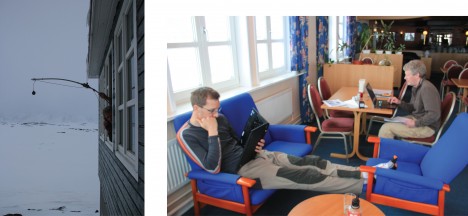
Left: Rick, calling with the satellite phone, using a homemade extended antenna (credit: Ludo). Right: Ludo and Rick waiting to hear back from Air Greenland about tomorrow’s flight. (Credit: Clément Miège.)
4 pm: Our flight for tomorrow is officially canceled.
7 pm: Even if it does not make any sense to have a passenger flight tomorrow due to this upcoming weather system, we think that it will be really valuable to have a cargo flight to drop our equipment. Hence, only one helicopter load will still need to be transported when the storm is over. We’re still working on this option.
We are not sure when we will be flying, but at least we are ready. Please keep your fingers crossed for some good weather. More updates soon, opa!
All the best from snowy Kulusuk!
By Clément Miège
YAY! We made it to Kulusuk on Saturday afternoon! It ended being a not-too-long journey, since all of our flights were on time.
Rick, Ludo and I followed different itineraries. Rick left Salt Lake City on Friday morning and a red-eye flight took him to Keflavik International Airport in Iceland. He landed early Saturday and took a bus from the international airport to the domestic airport in Reykjavik (an hour-long ride).
Ludo came from a meeting in Switzerland and arrived in Iceland late Friday night. He stayed at a nearby hostel in Keflavik. The next day, he was told to take a bus that would take him to the domestic airport and that supposedly departs every hour in the morning. After waiting for a while, with no bus in sight, he walked back to town (carrying 2 duffel bags, a ski bag, and 2 carry-on bags) and learned his first Icelandic words: Saturday and Sunday (laugardaga og sunnudaga.) Turns out, during the weekend, the bus schedule is different. Good thing that taxis were not too far and that he ended up making it on time for his 12:45 pm Greenland flight!
Me, I had a one-day layover in Reykjavik, which was a nice chance to rest a bit and quickly visit the city. I walked around town, not for too long because it was definitely cold and windy and I am not yet acclimated to cold temperatures — but I will be in the next few days!
Reykjavik is a nice city… when it’s not too windy. The day I arrived, the wind was gusting and it was just too cold. But I still went on a walk to check the Hallgrímskirkja church. This is the largest church in Iceland, an amazing structure! Inside, there is a lift, making the church a pretty sweet observation tower with nice views over the city.
[Note: Originally in this post, I erroneously said Halgrímskirja is a cathedral. Thanks to our reader Harry McKone for spotting the mistake!]
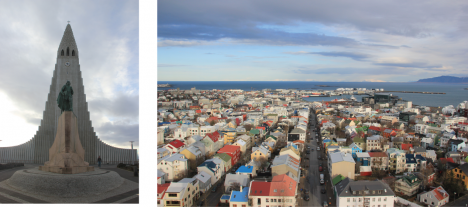
On the left, the church with the statue of Icelandic explorer Leif Eriksson. This story explains the first discovery of North America by a Viking expedition, led by Leif Eriksson about 500 years before Columbus: http://www.history.com/news/the-viking-explorer-who-beat-columbus-to-america. On the right, downtown Reykjavik, composed of colorful houses. (Credit: Clément Miège)
The next day, I joined Ludo and Rick at the domestic airport (they both arrived before me). Useless to say that we had a lot of gear between the 3 of us, a total of 6 carry-on bags (including laptops, radar computer, transmitters, GPS, etc.), 5 checked bags (with our cold weather gear), and 2 ski bags. We were a bit scared at first by Air Iceland’s policy of only allowing one 5kg carry-on and a 20kg checked bag per person, but we ended up getting through easily, which was a relief!
The flight was smooth and fast, only 2 hours to get to Greenland. Approaching Greenland, we started to see more and more winter sea ice along with some big icebergs trapped within it, which is always very pretty. The first islands finally appeared and we were about to land on one of them, where the little town of Kulusuk is.
Interestingly, the sea ice in the fjord next to Kulusuk seemed weaker and it might be thinner this year than when we visited last year. Ludo noticed some spots that were already ice free (see the photo below); those spots were covered by sea ice last April. The wind redistribution of the sea ice and the warm temperature in Kulusuk in January might be the reasons for this weaker sea ice pack.
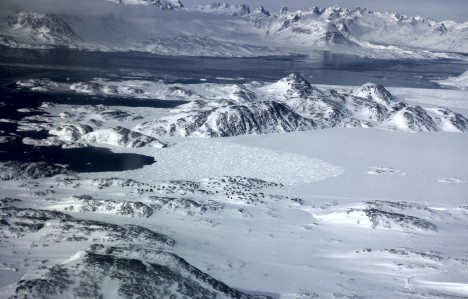
View from the plane of the sea ice around Kulusuk (the little black dots are houses.) (Credit: Ludovic Brucker)
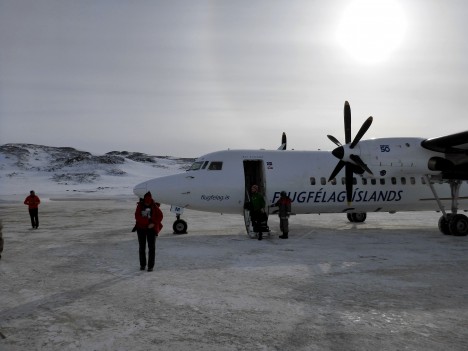
Our plane, freshly landed at the Kulusuk airport, with a faint sun halo in the background. (Credit: Rick Foster)
Shortly after landing, we made it to our hotel, and started to unpack. This year, Ludo and I brought back country skis, which is a really nice and fun improvement, and also a faster way to get from the hotel to the airport, or to go to the old garage where some equipment is stored from last year.
At the airport warehouse, we found all the equipment that we sent from the U.S. We counted the boxes and, great news, everything had made it her, and was in pretty good shape too! We started to unpack some items and took some of them to the hotel for re-organizing them some more.

At the Kulusuk airport, Ludo moves equipment around to consolidate our cargo (left). Some equipment is ready to be loaded on the helicopter (right) to go to our field site, but other gear needs some repacking, which will be one of our main tasks for the coming days. (Credit: Clément Miège.)
Today, a big storm is here and it’s a white-out outside — crazy, brrrrr! It is snowing horizontally. So happy we are not in the field right now! It is really windy this morning, about 37 mph, so we have decided to work indoors. We have couple projects: preparing antenna tubing for the low-frequency radar, preparing the radar sleds, assembling the ARGOS antenna pole, and starting to pull out the equipment from our last year’s storage place.
I can’t take any photos today, since it’s just white everywhere and impossible to see the surrounding buildings.
We are still on track for leaving this Thursday (March 27) to go to our camp site on the ice sheet. Amazingly, the only day of the week that looks good for flying out is Thursday — see the forecast below. That is lucky for us!
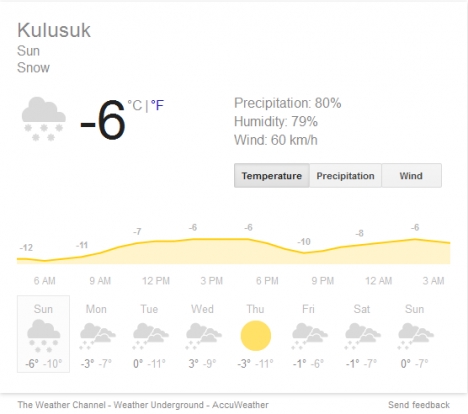
According to the Weather Channel, the only day with good weather this week is Thursday — good thing we are scheduled to leave then!
I’ll send a new blog post in a few days, stay tuned!
By Clément Miège
Hi there! I am Clément Miège, a Ph.D. student at the University of Utah and I am going to take you along with us to our second expedition to the southeast region of Greenland, to investigate the physical properties of a firn aquifer. And what is a firn aquifer, you might be wondering? It’s a reservoir of perennial water (that is, water that doesn’t freeze in the winter) that is trapped within the compacted snow layer (or firn) of the Greenland ice sheet. If you didn’t follow last year’s edition of this expedition and/or you want to learn more about the firn aquifer, here are some readings I recommend:
We are now getting ready for another expedition to Greenland to further monitor the firn aquifer. This year, our four main tasks will be to maintain our equipment currently in place (which performs temperature measurements), collect additional measurements (with a radar), install a weather station, and try traditional ground-water techniques to date the water and calculate its permeability. I will explain in future blog posts why these measurements are important.
I will be part of a smaller team this year, since only three out of the five members of the first-year team are joining. Rick Forster and I will represent the University of Utah, while Ludovic Brucker comes from NASA Goddard Space Flight Center.
Here is the photo of the team from last year, from left to right; Jay, Ludo, Rick, Lora and I. Lora and Jay won’t be coming to the field this year (we sure will miss them!) If you want to know a bit more about each team member (current and former), you can check this blog post from last year.
Even when we haven’t set a foot in the field yet, the expedition to Greenland started about two months ago with organizing the logistics. Logistics can sometimes be underestimated, but it takes a lot of effort prior to getting to the field to prepare and test the scientific equipment and other field supplies, such as camping gear, food, and power sources.
For this expedition, all of the science equipment (GPS, radars with different frequencies — 5MHz to 400MHz–, piezometers, ice-core drill) was gathered from different institutions in Utah to be packed here and shipped to Kulusuk. Most of the non-perishable food and camping gear was left for over-winter storage after last year’s expedition in a warehouse in Kulusuk, to save on shipping costs.
On March 3 this year, the Utah gear left for Greenland; we’re talking about 800 lbs. of gear that left Salt Lake City on a truck headed to the JFK airport in New York, where it was flown to Reykjavik (Iceland) and then to Kulusuk (Greenland). We got a phone call early this week from our shipping company to confirm that all our equipment made it to Greenland — great news!
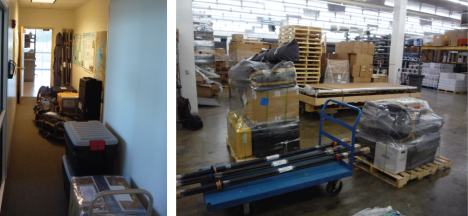
Gear packed at the office (left) and ready to leave the shipping facility at the University of Utah (right). We will see this gear again in Greenland!
These last days have been really busy, gathering the last items for our science research, and also personal equipment. Yesterday, I was working at Blue System Integration in Vancouver, BC with a colleague, Laurent Mingo, who is developing IceRadar, an ice-penetrating radar system for the scientific community (see this website for additional info). Laurent has been working on an experimental beta version of the current radar that will allow us to penetrate through the firn aquifer to try to image the bottom of the aquifer gradually transitioning from water-saturated firn to ice.
Even if most of the scientific equipment is already shipped, there are always some last-minute important items that we end up adding into our suitcases (like the low-frequency radar). As a brief anecdote, last year, Rick traveled with a pelican case as a checked bag – inside, there was a bunch of wires hooked up to a datalogger. We were aware that it looked kind of suspicious, so it was a bit scary to go through customs with it! Me, I traveled with a 60-meter long thermistor string weighing over 50 lbs. in my checked bag, because the fabrication and calibration took longer than expected and we weren’t able to ship it ahead of time with the rest of the equipment. This year, luckily, most of the heavy equipment was ready on time and we are carrying only a couple random items in our checked bags.
We are starting our journey this week, leaving the U.S. on Thursday evening for Reykjavik, the capital of Iceland. After a day in Reykjavik, we will leave mid-Saturday on a 2-hour short flight that will take us to Kulusuk, Greenland. We are hoping for good weather; last year, Ludo and I “boomeranged” on our first try due to poor visibility at the Kulusuk runway.
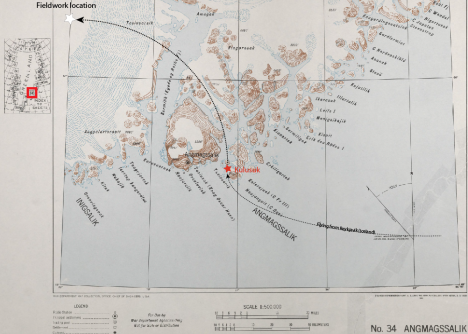
In this old map from the US army (from 1941) you can see the location of the small city of Kulusuk in Southeast Greenland (red star), just below the Arctic Circle (~66.5°N). Our field camp on the ice sheet is represented by a white star. The map can be found at the Polar Geospatial Center.
Kulusuk is our first stop in Greenland. We will be staying at this small village for a few days in order to re-pack our field gear, test that everything is working well (stoves, generators, tents, science equipment, etc.) before going to the field. If we are lucky, we might see one of the polar bears that sometimes come close to town in this time of year.
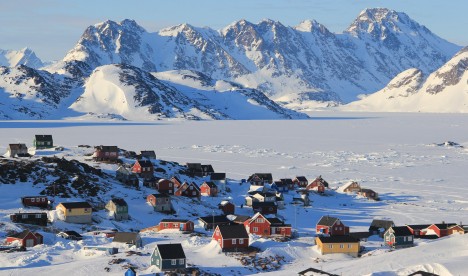
Colorful houses make up the town of Kulusuk in Southeast Greenland. The shores of the fjord are covered by sea ice in the winter.
After a couple of days, we will be heading to our fieldwork location on the ice sheet. A helicopter from Air Greenland will drop us and our cargo at our study site; it will be an about 45-minute commute.
That is it for this introduction; our next blog post will be from Greenland!
All the best,
Clément
By Lora Koenig
April 1, 2013 — I was tossing and turning this morning between 5 and 6:30 am, anticipating our 8:15 am scheduled take-off. Our gear was packed and we were ready to go. I rolled out of bed at 6:30, looked out the window and realized our luck had run out: I couldn’t see any of the beautiful peaks surrounding Kulusuk and snow was lightly falling. The pilots called our hotel at 8 am and told us the flight was delayed and they would reassess at 11 am when the next weather forecast would arrive. Eleven o’clock came and the weather had not changed, so our on-time put-in was canceled. Not only that, but we were told tomorrow was not an option either: due to the Easter holidays, tomorrow’s helicopter schedule is full transferring supplies to the smaller villages. It is typical to have delays, so we were not too disheartened. However, it was bit frustrating when all the clouds burned off around 2 pm and we had a beautiful blue-sky afternoon. It was too bad we couldn’t fly today. We all made the best of the situation and went out for a hike to enjoy the nice weather and some free time before the field work begins.
April fools!
Here’s what really happened: Yesterday we were told there was no chance we could fly today. Imagine our surprise when at 10 am the helicopter pilots called the hotel and said they would give us one of our three put-in flights at 11:20 am. We already have the gear for the three flights at the airport and had a put in plan just in case we had to split the fights, so we jumped into action. Rick, Clem and Ludo would be in the first helicopter load with emergency gear, gear to set up camp, food and the radar gear to do the initial survey to find the top of the water layer we are going to drill into. Rick, Clem and Ludo packed the last remaining items in their rooms, I filled water bottles and Jay got the hotel truck ready to haul us to the airport. (As I mentioned before, they are nice enough to let us use their truck.) Once at the airport we weighed our items and put them on the luggage carts. The helicopter arrived and was literally packed full of gear. Our first load is light at around 800 kg (we can have up to 950 kg including passengers), but it is bulky with all the tents and food. The helicopter pilot confirmed our location, asked about the conditions of the site from 2 years ago, when Clem was last there, gave a quick safety briefing and took off just after 11:45.
Now our team is split. Rick, Ludo and Clem will establish camp and complete the radar survey. Jay and I are still waiting in Kulusuk that camp is set up and all is well. The next check is at 4 pm (as a safety precaution, we always have check-in times). Tomorrow at noon we will start the last two put-in flights to bring the drills, the rest of the science equipment, Jay and I. Today’s was an eventful morning, but the fieldwork has officially started. The weather report is good for tomorrow and Jay and I are ready to go — we can even go early if the pilots decide to give us a call at breakfast.
If we get into the field tomorrow, we will transmit brief updates using our satellite phone to keep the blog updated. Then, when we get back from the field, if the Internet here is fixed,we can start sending more of our spectacular photos.
By Lora Koenig
March 31, 2013 — We just finished our last dinner, Easter dinner, in Kulusuk. We spoke with the helicopter pilots today and expect to have an 8:15 am flight to our location on the ice sheet about 100 km to the Northwest of Kulusuk, where the aquifer was drilled into last year for the first time.
We have had an exciting time in this beautiful village, population around 350. We are staying at the Hotel Kulusuk and have been their only visitors since we got here, something that comes with many perks. Bo, the chief and interim manager while the manager is on vacation, has allowed us to make ourselves at home. We had our science gear spread around the dining room, had access to the kitchen and hotel truck and were even allowed to hide candies around the hotel for Easter morning. The only thing we do not have, which we expected, was Internet. There is Internet in town but we currently can’t get log-on access and the person who can fix this is on vacation. He was supposed to return yesterday but didn’t show up on the flight so I imagine this blog post will be a bit delayed. All part of the adventure!
Not only do we have full run of the hotel but we are also granted some pretty amazing access to the airport, which has been storing all of our science cargo. Just yesterday after a plane landed, we walked right out to the baggage train to see if our gear had arrived. (A few days ago, Jay sorted one of the baggage carts just to be helpful since most of it was our gear anyway.) The plane was still on the tarmac but we are allowed to just walk around like we were employees. It is a small airport, and the manager knows us now. We have driven the airport trucks, which are unlocked with the keys inside, to move our gear. Car theft is not really an option here: there are only about 2 miles of road, which go from the airport to the hotel and to the warehouse were our cargo boxes are located, that’s it. Snowdrift on the road is higher than the roofs of the cars, so it feels like you are driving in a tunnel.
We were very anxious to get the plane cargo yesterday, March 30, because it was the last opportunity for our remaining gear to arrive before our scheduled put-in date. But let me start this story from the beginning. We have 2,030 kilograms (4,475 pounds) of gear that will accompany us into the field. As I wrote before, the gear was shipped from all over U.S. and took many different routes to get here. On Friday, March 30, we were told our generators and drill antifreeze coming in from Nuuk would not be arriving, but the back-up cutters coming in from Iceland would. With no generators to run the drill (which itself had only arrived on March 27), we would have to delay our put-in. Not only were we told the generators would not be coming in, but that all planes that could carry them would be full until April 6, which would force us to delay by a week. We quickly started looking around for a generator and found one. After a few phone calls, we were granted access to use it. This was great news but left us with one problem: the ~200 lbs generator was 15 feet up in a loft, with just a few ladders to get it down. We dug around the warehouse and found two pulleys. Ludo and Jay got some of our rope, hooked the pulleys up to the rafter, attached the generator and safely lowered it to the ground. It was quite a sight.
To replace the antifreeze, we called the hospital in Tasiilaq to see if they had any medical alcohol that they could spare. They said they could send us 10 liters, which was sufficient. By Friday night, we had found replacements allowing us to stay on schedule if the original gear didn’t arrive.
On Saturday morning, we went up to the airport expecting to find the drill cutters. We ended up leaving with our generators and alcohol… but no cutters. Exactly the opposite of what we expected to get, but that is often how it goes. This was all good news because the cutters were backups (we have another set), so we could still stay on schedule for the April 1 put-in.
Jay and I spent the rest of Saturday loading all of our gear, which we had sorted into three helicopter loads, into baggage carts at the warehouse. The first load has food and camp supplies, the second science gear and the third the drill. The cargo was taken to the airport, where we unloaded it from the carts, weighed each piece and reloaded it again. We have now moved the 2,030 kg of gear at least four times, by hand – my arms are tired!
Rick and Clem spent the past few days preparing our thermistor strings, one 25-m and one 60-m-long cables with temperature sensors on them, for deployment on the ice sheet. One of the most important pieces of our project is to leave the temperatures strings in the ice to measure temperatures at 86 locations over the next year. The temperatures will help us understand how the much water is in the aquifer and how the aquifer may have formed.
The weather looks good for us to leave Kulusuk behind tomorrow and start our work. Everything is ready. We are well-fed and will get a good last night of sleep in the nice, soft, warm beds at the hotel. There is just one bad thing that has happened during our time in Kulusuk: everyday has been sunny and warm with no wind. “Why is this bad?”, you might wonder. Remember this is one of the snowiest and windiest areas of Greenland so, statistically, we know some bad weather will need to offset this good weather strike. We hope we do not have to pay for the current clear skies next week when we are in our tents trying to do science.